Panzerhaubitze 2000
The Panzerhaubitze 2000 ("armoured howitzer 2000"), abbreviated PzH 2000, is a German 155 mm self-propelled howitzer developed by Krauss-Maffei Wegmann (KMW) and Rheinmetall for the German Army. The PzH 2000 is one of the most powerful conventional artillery systems deployed in the 2010s. It is capable of a very high rate of fire; in burst mode it can fire three rounds in nine seconds, ten rounds in 56 seconds, and can—depending on barrel heating—fire between 10 and 13 rounds per minute continuously.[1] The PzH 2000 has automatic support for up to 5 rounds of Multiple Rounds Simultaneous Impact (MRSI). The replenishment of shells is automated. Two operators can load 60 shells and propelling charges in less than 12 minutes. PzH 2000 has also been selected by the armies of Italy, Netherlands, Greece, Lithuania and Croatia, and more orders are probable as many NATO forces replace their M109 howitzers.
| Panzerhaubitze 2000 | |
|---|---|
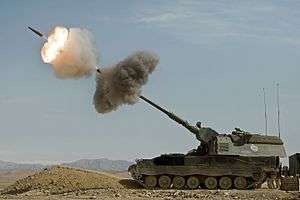 Panzerhaubitze 2000 in profile | |
| Type | Self-propelled gun |
| Place of origin | Germany |
| Service history | |
| In service | 1998–present |
| Wars | War in Afghanistan |
| Production history | |
| Designed | 1987–1996 |
| Unit cost | DM 9 million (1996) |
| Produced | 1996–present |
| Specifications | |
| Mass | Combat: 55.8 t (61.5 short tons) |
| Length | 11.7 m (38 ft 5 in) |
| Width | 3.6 m (11 ft 10 in) |
| Height | 3.1 m (10 ft 2 in) |
| Crew | 5 (commander, driver, gunner, and two loaders) |
| Rate of fire | 3 rounds in 9.0 seconds (Burst) 10 rpm |
| Effective firing range | DM121 Boattail: 30–36 km (19–22 mi) M1711 Basebleed: 40–47 km (25–29 mi) RAP: 67 km (42 mi) |
| Armor | welded steel, 14.5 mm resistant additional bomblet protection |
Main armament | Rheinmetall 155 mm L52 Artillery Gun 60 rounds |
Secondary armament | 7.62 mm Rheinmetall MG3 machine gun |
| Engine | MTU 881 Ka-500 1,000 PS (986 hp, 736 kW) |
| Power/weight | 17.92 PS/t |
| Suspension | torsion bar |
Operational range | 420 km (260 mi) |
| Maximum speed | Road: 67 km/h (41 mph) Off-road: 45 km/h (28 mph) |
Development
In 1986 Italy, the United Kingdom and Germany agreed to terminate their existing development of the PzH 155-1 (SP70) programme, which had run into reliability problems and had design defects, notably being mounted on a modified tank chassis. A new Joint Ballistics Memorandum of Understanding (JBMOU) for a 52 calibre barrel (based on a UK proposal) to replace 39 calibre was nearing agreement. German industry was asked for proposals to build a new design with gun conforming to the JBMOU. Of the proposed designs, Wegmann's was selected. Wegman eventually won a contract in 1996 for 185 to be delivered to Germany's rapid reaction force, followed by another 410 for the main force. Wegmann and Krauss-Maffei, the two main German military tracked vehicle designers, merged in 1998 to form KMW.
Design
Rheinmetall designed the 155 mm 52-calibre JBMOU compliant gun, which is chromium-lined for its entire 8 metre length and includes a muzzle brake on the end. The gun uses a new modular charge system with six charges (five identical), which can be combined to provide the optimal total charge for the range to the target, as well as the conventional bagged charge systems. Primer is loaded separately via a conveyor belt, and the entire loading, laying and clearing is completely automated. The maximum range of the gun is 30–36 km with the standard DM121 Boattail round, about 40–47 km with base bleed rounds, and 67 km with M2005 V-LAP assisted projectiles.[2] In April 2006 a PzH 2000 shot assisted shells (Denel V-Lap) over a distance of 56 km with a probable maximum range of over 60 km.[3] The gun can also fire the SMArt 155 artillery round, which is used by Germany and Greece.
Wegmann supplied both the chassis, sharing some components with the Leopard 2, and the turret for the gun. The system has superb cross-country performance because of its use of continuous tracks and considerable protection in the case of counter-fire. The turret includes a phased array radar on the front glacis for measuring the muzzle velocity of each round fired. Laying data can be automatically provided via encrypted radio from the battery fire direction centre.
A lighter, more air-portable version, using the gun in a module fitted to a lighter chassis, has been developed by KMW. It is called the Artillery Gun Module.
In December 2013, Raytheon and the German Army completed compatibility testing for the M982 Excalibur extended range guided artillery shell with the PzH 2000. Ten Excaliburs were fired at ranges from 9 to 48 kilometers. Shells hit within three meters of their targets, with an average miss distance of one meter at 48 km. The Excalibur may be accepted by the German Army in 2014.[4]
A PzH 2000 L52 gun fired a shell to a range of 67 km at the Alkantpan test range in South Africa on 6 November 2019.[5]
Combat record and alterations
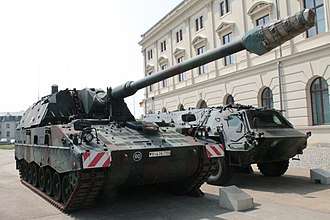
The PzH 2000 was used for the first time in combat by the Dutch Army in August 2006 against Taliban targets in Kandahar Province, Afghanistan, in support of Operation Medusa.[6] Since then it has been used regularly in support of coalition troops in Uruzgan province, also in Afghanistan. The PzH 2000 was also used extensively during the Battle of Chora. It is known as "the long arm of ISAF". The gun has been criticised by the Dutch in Uruzgan province as the NBC system designed for use in Europe cannot cope with the high level of dust in Afghanistan. The guns have been modified with additional armor being fitted to the roof to protect against mortar rounds. There have been other reports of problems including the need to keep it in the shade unless actually firing, the damage it does to poorly built roads and a significant 'cold gun' effect necessitating the use of 'warmers'.
Since the beginning of June 2010, German ISAF troops at PRT Kunduz have three PzH 2000 at their disposal. They were first used on 10 July 2010 to provide support for the recovery of a damaged vehicle. This was the first time in its history the Bundeswehr has used heavy artillery in combat.[7] The PzH 2000 also played a key role during Operation Halmazag in November 2010, when the villages of Isa Khel and Quatliam were retaken from the Taliban by German paratroopers.[8]
Operators
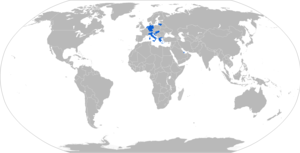
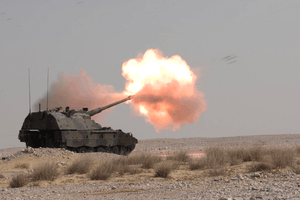
Current operators








Exports
A number of armies have tested the system and its ability to provide accurate fire at 40 km has been a major selling point.
The PzH 2000 was considered for the US Army's Crusader concept system, but several requirements of the Crusader made it unsuitable. The Crusader specifications placed the crew and gun in separate compartments, allowing a single highly armoured crew compartment to control the firing of an entire battery of guns through intervehicle links. In addition the Crusader included an automated ammunition tender, and an active cooled barrel.[22]
The PzH 2000 was a contender for Phase 1C of Australia's Land 17 Artillery Replacement Programme prior to that phase of the project being cancelled in May 2012.[23]
Finland tested one alongside the 155mm SpGH ZUZANA and AS-90 "Braveheart". Tests ended in 1998 and due to cost efficiency issues no self-propelled gun system was selected, but instead more of the cheaper 155 K 98 field guns were bought.[24]
The German Navy evaluated a modified system known as MONARC for installation onboard frigates; while the system performed well components were difficult to protect against corrosion. Sweden evaluated a slightly modified version but selected the ARCHER Artillery System instead.
In December 2018, Hungary ordered 24 newly built PzH 2000s from Krauss-Maffei Wegmann together with 44 Leopard 2A7+ and 12 Leopard 2A4 main battle tanks in a deal valued at over 160 billion HUF ($565 million).[14][15]
Gallery
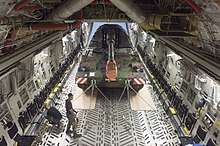 Dutch howitzer being transported to Afghanistan.
Dutch howitzer being transported to Afghanistan.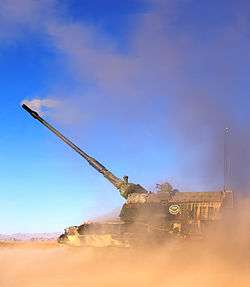 Dutch PzH-2000 firing on targets in Chora. June 16, 2007..
Dutch PzH-2000 firing on targets in Chora. June 16, 2007..- Croatian PzH 2000 at Zagreb Military Parade
.jpg) Remote firing of the PzH 2000 by a German Army soldier in Kunduz, Afghanistan (July 2010)
Remote firing of the PzH 2000 by a German Army soldier in Kunduz, Afghanistan (July 2010)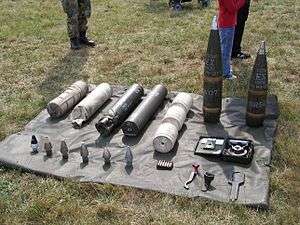 Ammunition
Ammunition- Italian Pzh-2000 on display at Rome's Circus Maximus for the 2009 Army Day
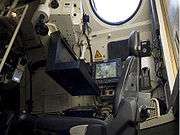 Interior view of an Italian Pzh-2000
Interior view of an Italian Pzh-2000.jpg) German soldiers with 4th Battery, 131st Artillery Battalion carry out a fire mission with self propelled howitzers.
German soldiers with 4th Battery, 131st Artillery Battalion carry out a fire mission with self propelled howitzers.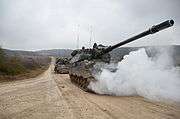 Dutch soldiers of Bravo Battery, Fire Support Battalion drive Panzerhaubitze 2000 into a simulated ambush.
Dutch soldiers of Bravo Battery, Fire Support Battalion drive Panzerhaubitze 2000 into a simulated ambush.- Panzerhaubitze 2000 engine.
Similar vehicles
- AS-90
- Bandkanon 1C
- 2S35 Koalitsiya-SV, derived from Msta
- 2S19 Msta, Msta S M K and other related
- Type 99
- M109 howitzer
- GCT 155mm
- K-9 Thunder
- AHS Krab
- T-155 Fırtına
- PLZ-05
- SSPH Primus
- Sholef
See also
References
- Army Technology with data on PzH 2000 Archived 2008-10-07 at the Wayback Machine
- Panzerhaubitze 2000 – Konzepte zur Schließung der Reichweitenlücke
- KMweg.de Archived September 27, 2007, at the Wayback Machine
- German Army PzH 2000 Howitzer Test Fires Excalibur 155mm Artillery Projectile Archived 2014-08-10 at the Wayback Machine - Deagel.com, 10 December 2013
- Rheinmetall develops new long-range howitzer
- "Archived copy". Archived from the original on 2007-09-28. Retrieved 2007-03-02.CS1 maint: archived copy as title (link)
- Bundeswehr setzt erstmals schwere Artillerie ein Archived 2013-12-05 at the Wayback Machine. Hamburger Abendblatt, 12 July 2010
- Der Kampf um Quatliam Archived December 4, 2013, at the Wayback Machine, by David Schraven (in German)
- "PzH Howitzer test firing" (Press release). Ministry of Defence of Croatia. 28 June 2017. Archived from the original on 6 August 2017. Retrieved 29 June 2017.
- Nicholas, de Larrinaga (29 July 2015). "Croatia receives first PzH 2000". IHS Jane's 360. IHS Jane's 360. Archived from the original on 2 August 2015. Retrieved 8 August 2015.
- "Signing of Agreement on Procurement of German PzH 2000 Howitzers" (Press release). Ministry of Defence of Croatia. 9 December 2014. Archived from the original on 29 June 2018. Retrieved 29 June 2018.
- "Contract For 24 PzH 2000 Self-Propelled Howitzers Signed With Greece". defense-aerospace.com (Press release). Briganti et Associés. 5 July 2001. Archived from the original on 2018-06-29. Retrieved 29 June 2018.
- https://esut.de/2019/11/fachbeitraege/ruestung/16730/panzerhaubitze-2000-konzepte-zur-schliessung-der-reichweitenluecke/
- Braatz, Kurt (19 December 2018). "Krauss-Maffei Wegmann unterstützt ungarische Heeres-Modernisierung" (PDF). Krauss-Maffei Wegmann (in German). Munich. Archived (PDF) from the original on 20 December 2018. Retrieved 22 December 2018.
- Dunai, Peter (20 December 2018). "Update: Hungary orders Leopard 2 MBTs and PzH 2000 SPHs". IHS Jane's 360. Budapest. Archived from the original on 21 December 2018. Retrieved 22 December 2018.
- "Oto Melara: Italian Army Contract for 70 PZH 2000 Self-Propelled Howitzers". defense-aerospace.com (Press release). Briganti et Associés. 17 December 2002. Archived from the original on 2018-06-29. Retrieved 29 June 2018.
- "Lietuva iš Vokietijos perka kelias dešimtis haubicų". Archived from the original on 23 October 2017. Retrieved 28 December 2016.
- "The Netherlands Sign Contract For PzH 2000 Self-Propelled Howitzers". defense-aerospace.com (Press release). Briganti et Associés. 1 May 2002. Archived from the original on 29 June 2018. Retrieved 29 June 2018.
- "Vuursteun Commando Koninklijke Landmacht". defensie.nl (in Dutch). Ministerie van Defensie. 23 September 2019. Retrieved 1 December 2019.
- "Krauss-Maffei Wegmann Supports Qatar's Army Moderni zation" (PDF) (Press release). Krauss-Maffei Wegmann GmbH & Co. KG. 2013-04-18. Archived (PDF) from the original on 2013-05-31. Retrieved 2013-04-18.
- Hickmann, Christoph; Berlin, Georg Mascolo. "Waffenexporte: Deutschland liefert Kampfpanzer nach Katar". Archived from the original on 2 January 2017. Retrieved 28 December 2016 – via Sueddeutsche.de.
- "Archived copy". Archived from the original on 2015-04-09. Retrieved 2015-04-04.CS1 maint: archived copy as title (link)
- "Rethink of Defence projects to save billions". ABC Online. May 3, 2012. Archived from the original on May 3, 2012. Retrieved May 3, 2012.
- "Archived copy". Archived from the original on 2011-05-14. Retrieved 2011-03-04.CS1 maint: archived copy as title (link)
External links
| Wikimedia Commons has media related to Panzerhaubitze 2000. |